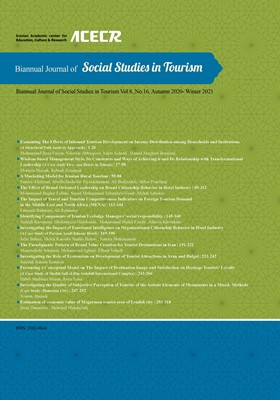A marketing model for Iranian rural tourism
Subject Areas :
سمیرا الهیاری
1
,
Abolfazl Tajzadehnamin
2
*
,
Ali Badizadeh
3
,
akbar pourfaraj
4
![]()
1 -
2 - Allameh Tabataba’I University
3 -
4 - Allameh Tabataba’I University
Keywords: Marketing Model#destination tourism#Rural tourism,
Abstract :
The main purpose of this study was to develop the model of rural tourism for Iranian organizations. The philosophy of the research is Interpretivism, the approach is deductive, and the strategy is the case study. In this research, by using multiple case study method and pluralistic approach, three companies of Tourism in Iran have been chosen and studied. Finally, interviews were conducted with 7 managers and elites. In each company, the current process of Rural tourism marketing and recommendatory Marketing model, by using different methods like semi-structured interviews, observation, and document analysis have been explored and have been defined. Then the suggested concepts of the interviews were analyzed and finally, the proposed model was drawn after comparing with the theoretical basis of the research and final analysis of the data obtained from the interviews. The results indicate that the Marketing model of rural tourism in Iran Includes four dimensions of environmental analysis(General and specialized environment), marketing planning(Mission, environmental intelligence, market-entry, more and Building Brand), operational planning(marketing mix and networking), and outcomes.
احمديان، محمدعلي؛ عليزاده، كتايون و بوكاني، رشيد. (1395). «نقش گردشگري در توسعه روستايي شهرستان مريوان». مجله جغرافيا. دوره 14 (دوره جديد)، شماره 51. صص 325 - 350.
دیوسالار، اسدالله. (1395). «نقش صنایع دستی در اقتصاد گردشگری روستایی مورد: روستاهای کوهپایهای شهرستان بهشهر». مجله اقتصاد فضا و توسعه روستایی. ۵ (۱۶). ۱۶۱-۱۷۴.
روستا، احمد؛ ونوس، داور و ابراهیمی، عبدالحمید. (۱۳۹۳). مدیریت بازاریابی. تهران: سمت.
شارپلی، جولیا و شارپلی، ریچارد. (1380). گردشگری روستایی. ترجمه: فاطمه نصیری و رحمتالله منشیزاده. تهران: منشی.
صيدايي، سيداسكندر و هدايتي مقدم، زهرا. (1389). «نقش امنيت در توسعه گردشگري». مجله علوم اجتماعی. 4(8), 97-110.
کاظمیه، فاطمه. (۱۳۹۴). «ارائه مدل ترویج توسعه گردشگری روستایی در نواحی روستایی استان آذربایجان شرقی». رساله دکتری، دانشگاه تربیت مدرس.
لطفي، حيدر. (1395). «بررسي توزيع جغرافيايي قومیتهای ايران و نقش آن بر تحولات آينده». مجله جغرافيا. دوره 14 (دوره جديد)، شماره 51. صص 367 - 385.
متقی، سمیر؛ صادقی، محمد و دلالت، مراد. (1395). «نقش امنیت در توسعه گردشگری خارجی (نمونه موردی: گردشگران خارجی شهر یزد)». مجله گردشگری شهری. 3(1). 77-91.
نساجی کامرانی، مهدی؛ کریمی، اوژن؛ محمودی میمند، محمد و درویش، حسن. (1396). «تبیین مدل عوامل مؤثر بر ارتقاء برند گردشگری جمهوری اسلامی ایران». مجله مدیریت سازمانهای دولتی. 5(شماره 4 (پیاپی 20)). صص 95-106.
ویسی، هادی و مهماندوست، خدیجه. (1394). «بررسی موانع توسعه صنعت گردشگری بینالمللی در ایران با تأکید بر گردشگری ورودی». مجله بین المللی ژئوپلیتیک. 11(37). 197-194.
Braun, V., & Clarke, V. (2006). Using thematic analysis in psychology. Qualitative research in psychology, 3(2), 77-101.
Brendan, C., 2016, Tourism Culture: Nexus, Characteristics, Context and Sustainability, Tourism Management, Vol. 53, PP. 229–243.
Cateora, P. R., Gilly, M. C., & Graham, J. L. (2007). Marketing internacional. AMGH Editora. Czinkota, M. R., & Ronkainen, I. A. (2007). International marketing. Cengage Learning.
David, F. R. (2011). Strategic management: Concepts and cases. Peaeson/Prentice Hall.
George, E. W., Mair, H., & Reid, D. G. (2009). Rural tourism development: Localism and cultural change. Channel View Publications.
Purbasari, N., & Manaf, A. (2018). Comparative Study on the Characteristics of Community-Based Tourism between Pentingsari and Nglanggeran Tourism Village, Special Region Yogyakarta. In E3S Web of Conferences (Vol. 31). CONF, EDP Sciences.
Hiransomboon, K. (2012). Marketing mix affecting accommodation service buying decisions of backpacker tourist traveling at Inner Rattanakosin Island in Bangkok, Thailand. Procedia Economics and Finance, 3, 276-283.
Jones, E (2010), Arab Politics and Tourism: Political Change and Tourism inthe Great Socialist People’s Libyan Arab Jamahiriya, In: Tourism and PoliticalChange, Edited by R. Butler and W. Suntikul, Oxford: Goodfellow.
Kim, J. H. (2014). The antecedents of memorable tourism experiences: Thedevelopment of a scale to measure the destination attributes associated withmemorable experiences. Tourism management, 44(2014): 34-45.
Kim, J. H., Ritchie, J. R. B. & McCormick, B. (2012). Development of a scale tomeasure memorable tourism experiences. Journal of Travel Research, 51(1):12-25.
Kotler, P., Keller, K. L., Ancarani, F., & Costabile, M. (2014). Marketing management 14/e. Pearson.
Kumar Dhiman, A., & Sharma, H., (2009), Services marketingmix in library & information centers. ICAL, advocacy & marketing,pp 460-456.
Lynch, R. L., & Smith, J. R. (2015). Strategic Management. Pearson Education Limited .
Martin, H.S. and Bosque, G.D. (2008). Exploring the cognitive–affective natureof destination image and the role of psychological factors in its formation, Tourism Management, 29: 263–277.
McDonald, M., & Payne, A. (2006). Marketing plans for service businesses: a complete guide. Elsevier.
Mudie, P., & Pirrie, A. (2006). Services marketing management. Routledge.
Nagaraju L.G. and B. Chandrashekara(2014). Rural Tourism and Rural Development inIndia, International Journal of Interdisciplinary and Multidisciplinary Studies (IJIMS), Vol1, No.6, pp1-345.
Phitthayaphinant,P., & Nissapa,A., (2011), Consumersu Satisfactionon Marketing Mix of Biodiesel in Southern Thailand: A Case Study in Songkhla, Krabi, and Trang Provinces. KasetsartJ., (Soc. Sci), No 32, pp 124-115.
Pizam, A. (2010). Creating memorable experiences. International Journal of Hospitality Management, 29(3): 343.
Qu, H., Kim, L. H., & Im, H. H. (2011). A model of destination branding: Integrating the concepts of the branding and destination image. Tourism management, 32(3), 465-476.
Roberts, L., Hall, D., & Morag, M. (2017). New directions in rural tourism. Routledge.
Ruskin-Brown, I. (2005). Marketing your service business. Thorogood Publishing.
Saghaei, M (2007), Possibility of Eco-tourism in Iran, Conference of Geography: Tourism and Sustainable Development, Tehran: Shahre Rey’sIslamic Azade University[in Persian]
Sharpley, R., & Sharpley, J. (1997). Rural tourism. An introduction (pp. 1-165). International Thomson Business Press.
Silverman, G. (2011). Secrets of word-of-mouth marketing: how to trigger exponential sales through runaway word of mouth. Amacom books.
Strauss, A., & Corbin, J. (1998). Basics of qualitative research techniques. Thousand Oaks, CA: Sage publications.
WorldTourismOrganization. (2017). UNWTO Annual Report 2016. Madrid.
Yin, R. K. (2017). Case study research and applications: Design and methods. Sage publications.

